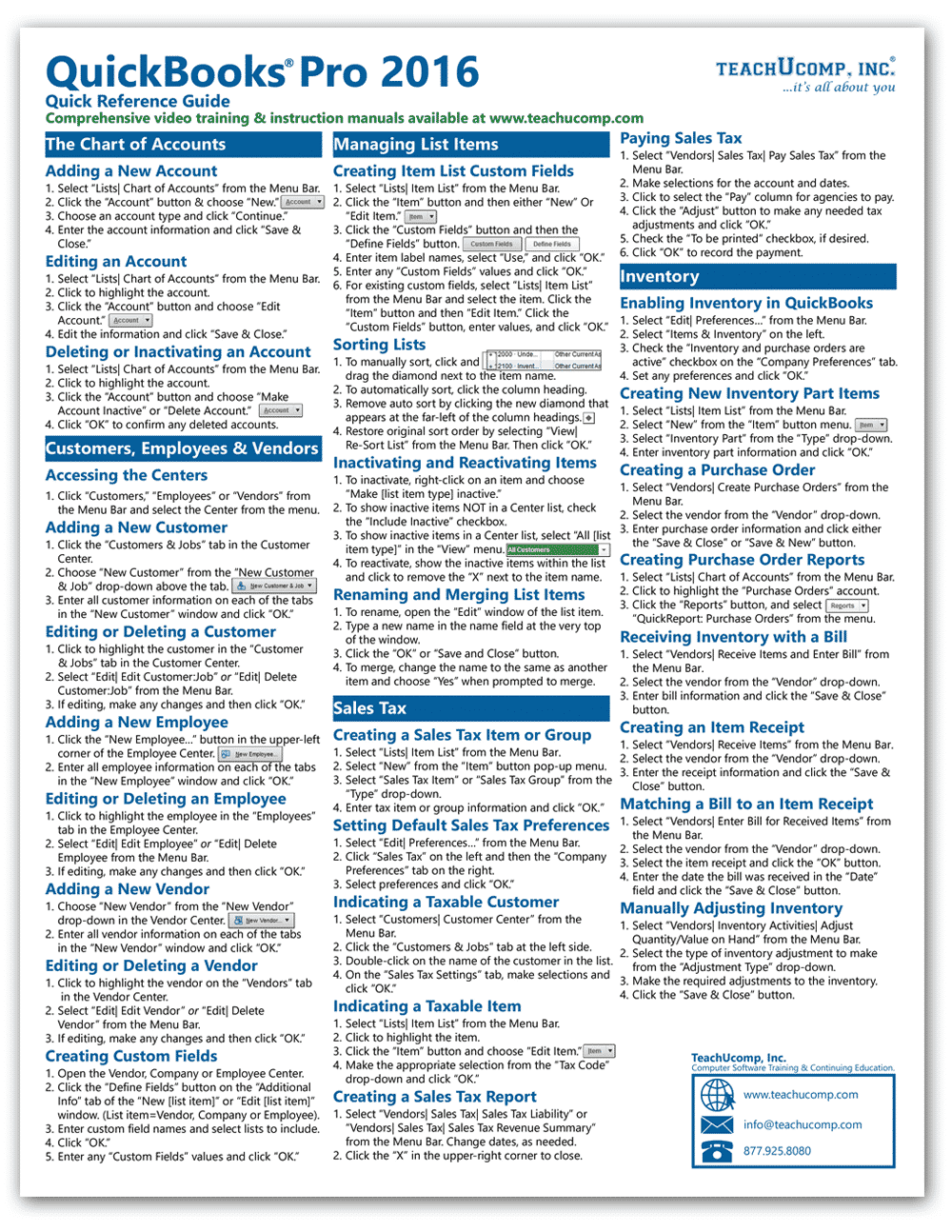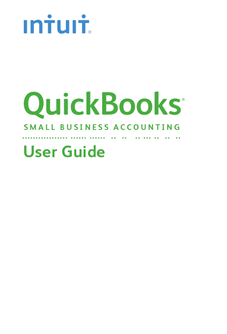Quickbooks Reference Guide 2016 Pro
Keeping Your Debits and Credits Straight in QuickBooks Simple Start To keep track of your debits and credits in QuickBooks Simple Start, remember that the left (debit) is the natural balance for asset accounts, and the right (credit) is the natural balance for liability and owner’s equity accounts. Remember: Assets=Liabilities +Owner’s Equity.
(The exceptions are contra accounts and expense accounts that add or deduct from other accounts to form a net amount.) Account Type Debits Credits Assets Increase asset accounts Decrease asset accounts Liabilities Decrease liability accounts Increase liability accounts Owner’s equity Decrease owner’s equity accounts Increase owner’s equity accounts Income Decrease income accounts Increase income accounts Expenses Increase expense accounts Decrease expense accounts. QuickBooks Simple Start Keyboard Shortcuts When you’re working in QuickBooks Simple Start, take advantage of keyboard shortcuts for efficiency. Although they may take a while to internalize, keyboard shortcuts can save you a lot of time. Right-Click to Perform Common Tasks in QuickBooks Simple Start To perform a common task related to a window, transaction, or item in QuickBooks Simple Start, you can use the right mouse button to display a shortcut menu.
For example, right-clicking often displays commands for deleting or voiding the transaction or creating a QuickReport on the transaction. The commands vary depending on the type of transaction you select or the window you’ve right-clicked. In a register, select and right-click a specific transaction. In a list, right-click an item. In a form, display a transaction and right-click a blank area of the form. In a list window, right-click somewhere inside the window. Some QuickBooks Simple Start User Interface Tricks Working your way through QuickBooks Simple Start is easier when you use these tricks to navigate through the QuickBooks Simple Start program and interact with the system’s displays.
Here are a few user interface tips:. To get help, press the F1 function key. QuickBooks starts the Help program and shows you information about the part of the QuickBooks program you’re working in. To move quickly to a specific list box entry, press the letter. To select a list box entry and choose a dialog box’s suggested command button, double-click the entry.
To move the insertion point to the beginning of a field, press Home. To move the insertion point to the end of a field, press End. To move to another program, click the other program’s button on the Windows task bar. To move back to the QuickBooks program, click the QuickBooks task bar button. To minimize the QuickBooks program window (so you can see or work with whatever is underneath the QuickBooks program window), click the Minimize button in the upper-right corner of the Quickbooks program window. The minimize window shows a picture of a task bar button.
Some QuickBooks Simple Start Calculation and Editing Tricks These Quickbooks Simple Start tips can help you work easily through math calculations if you’re in the amount field, and editing the day if you’re in the date field.
Keeping Your Debits and Credits Straight in QuickBooks Simple Start To keep track of your debits and credits in QuickBooks Simple Start, remember that the left (debit) is the natural balance for asset accounts, and the right (credit) is the natural balance for liability and owner’s equity accounts. Remember: Assets=Liabilities +Owner’s Equity. (The exceptions are contra accounts and expense accounts that add or deduct from other accounts to form a net amount.) Account Type Debits Credits Assets Increase asset accounts Decrease asset accounts Liabilities Decrease liability accounts Increase liability accounts Owner’s equity Decrease owner’s equity accounts Increase owner’s equity accounts Income Decrease income accounts Increase income accounts Expenses Increase expense accounts Decrease expense accounts.

QuickBooks Simple Start Keyboard Shortcuts When you’re working in QuickBooks Simple Start, take advantage of keyboard shortcuts for efficiency. Although they may take a while to internalize, keyboard shortcuts can save you a lot of time. Right-Click to Perform Common Tasks in QuickBooks Simple Start To perform a common task related to a window, transaction, or item in QuickBooks Simple Start, you can use the right mouse button to display a shortcut menu. For example, right-clicking often displays commands for deleting or voiding the transaction or creating a QuickReport on the transaction. The commands vary depending on the type of transaction you select or the window you’ve right-clicked. In a register, select and right-click a specific transaction. In a list, right-click an item.


Free Quickbooks Reference Guide
In a form, display a transaction and right-click a blank area of the form. In a list window, right-click somewhere inside the window. Some QuickBooks Simple Start User Interface Tricks Working your way through QuickBooks Simple Start is easier when you use these tricks to navigate through the QuickBooks Simple Start program and interact with the system’s displays. Here are a few user interface tips:. To get help, press the F1 function key. QuickBooks starts the Help program and shows you information about the part of the QuickBooks program you’re working in.
To move quickly to a specific list box entry, press the letter. To select a list box entry and choose a dialog box’s suggested command button, double-click the entry. To move the insertion point to the beginning of a field, press Home. To move the insertion point to the end of a field, press End.
Quickbooks Pro 2016 Reference Guide
To move to another program, click the other program’s button on the Windows task bar. To move back to the QuickBooks program, click the QuickBooks task bar button. To minimize the QuickBooks program window (so you can see or work with whatever is underneath the QuickBooks program window), click the Minimize button in the upper-right corner of the Quickbooks program window. The minimize window shows a picture of a task bar button. Some QuickBooks Simple Start Calculation and Editing Tricks These Quickbooks Simple Start tips can help you work easily through math calculations if you’re in the amount field, and editing the day if you’re in the date field.